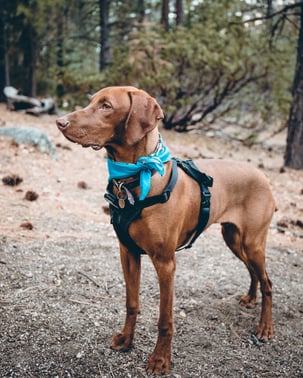The Best Dog Leashes and Harnesses
Updated on: February 15, 2023 | Author: Starwood Pet Travel

The array of dog collars, harnesses, and leashes available today boggles the mind. You have to choose something because good pet etiquette (and, usually, the law) requires your dog to be on a leash in public. This can be even more important if you’re moving to a foreign country. But how in the world are you supposed to know which is best for your puppy or dog?
A tool for every purpose
There are so many choices because dogs themselves are so different. Besides, who doesn’t want their pooch to look appropriately fashion-forward when walking out and about? Collars, leashes, and harnesses come in a vast selection of colors and patterns, so you’re sure to find something that matches your pup’s personal style. But the real purpose of harnesses and leashes is control.
Some dogs are naturally easier to train and control than others. And that’s why you have so many options. Harnesses have grown in popularity compared to standard-style collars because they give you more ways to teach and control your dog without jerking their neck, which can injure them. Rather than circling your dog’s neck, a harness has straps that go around the chest, back and belly.
Scale matters, too. A tiny dog shouldn’t have to stagger along in a heavy harness or leash. And narrow, feather-weight equipment may not be strong enough to control your big, strong dog.
Getting some advice from your veterinarian or a professional dog trainer can point you in the best direction for your pooch.
Flat collar
A good choice if your dog is well-behaved, but not for slender-headed Whippets and Greyhounds, who can easily slip out.
Back-clip harness
Attaching the leash to the dog’s back is better for snub-nosed breeds, but it can encourage pulling.
Chest-clip harness
This is the preferred style for dogs who pull because it is easier to steer them around to face you.
Head halter
This is a training device that wraps gently around your dog’s snout. It is not a muzzle.
Choke chains and pinch collars
Don’t use these unless your vet or trainer specifically recommends one and you understand how to use it properly. Otherwise, you could severely injure your dog. A martingale collar allows gentle tightening without overdoing it.
Breakaway collar
Many pet experts recommend removing your dog’s collar when they are not under your supervision. Or you can look for a breakaway collar that automatically releases if it gets caught on something while your dog is playing.
Adjustability
A collar or harness should be snug enough to prevent your dog from slipping out of it, but not too loose – you should be able to slip just two fingers between the collar and the dog. An overly-loose fit invites your crafty pup to slip their lower jaw under the chest strap, so they can gnaw away at it, unnoticed by you.
Although a few brands of harnesses lack adjustability, you can also find versions that have as many as five adjustment points for a truly custom and comfortable fit. Nonetheless, if your puppy is young now but will grow to be a very big dog, you may have to up-size to a new collar/harness later, no matter how many adjustment points the harness has.
Convenience and comfort features
Look for features that improve the experience for your dog and for you, such as:
- Ease of use – some styles are easier to put on than others
- Leash attachments in both front and back
- Padding that keeps the straps from chafing your dog
- A loop handle on the back, in case you need to lift your dog or hold them close
- Extra loops to attach tags or charms
- Product Guarantee
- Consider walking harnesses that doubles as a car-restraint
Identification
If you and your dog should become separated, your best chance to get them back is to make sure they are microchipped. That said, they should have identification (including your contact information) on their collar or harness. You can buy hanging tags at any pet supply store or online.
Leashes
Some pet parents like retractable leashes because they allow your pooch to wander more while on a walk. That’s okay if it works for you and you’re in a safe environment. But these leashes are not appropriate for training your dog to walk reliably on a leash, so trainers recommend using a standard straight 6’ leash instead. You can choose leather or nylon. Retractable leashes also aren't great for larger, stronger breeds.
Of course, it takes more than buying a harness to ensure your dog will walk well and obey on a leash. Obedience classes teach both of you how to walk together harmoniously, even under challenging conditions such as squirrel sightings. Once your dog is properly outfitted and walks nicely with you, you’re ready for almost any adventure. Don’t forget to take plenty of selfies!
Subscribe to the Blog
Enjoy our content? Get them sent to your inbox!
Subscribe Now!

